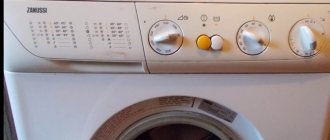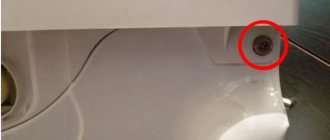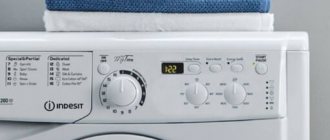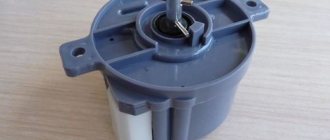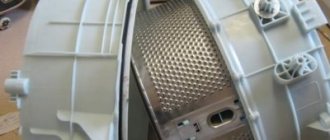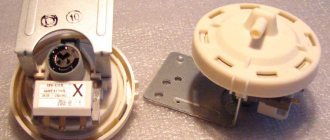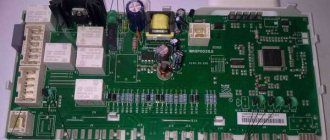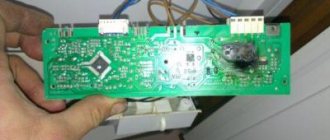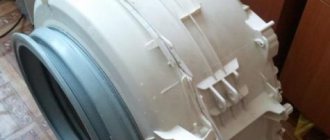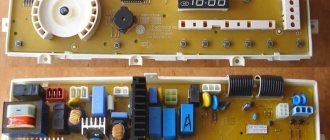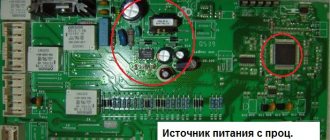Usually the Saturn semi-automatic washing machine is in great demand, which is not surprising, because this brand is considered the best in terms of the old “price/quality” combination. But not every person is able to choose the right model for him or understand the series on the market.
Top loading washing machine SATURN ST-WM0603 Green
There are too many models in the line. In addition, this brand is not suitable for everyone, since its pros and cons are quite situational. No one will believe the words from the developer’s website, since all the articles and reviews there are written to order. But what is the situation like in reality?
Features of the cars
The Saturn washing machine is presented in only one variation: semi-automatic. They differ from automatic ones in two important features.
Namely:
- Water must be filled in manually, since the machine is not connected to a centralized water supply.
- The fluid temperature must be adjusted manually.
They are fairly small plastic containers into which laundry is loaded, as well as water and powder. After this, the washing machine hose is led into the sink, and the device starts.
SATURN ST-WK 7603
Low price
One of the most important advantages of such mechanisms is their low cost. Despite the fact that spare parts for the Saturn washing machine, including the gearbox, are not very cheap, the final price of the mechanism is amazing. It is perfect for infrequent use, for example, at the dacha or in a country house. By spending not too much money, you can forget about dirty clothes. The stereotype that cheap things are always very bad was destroyed in this case.
Semi-automatic washing machine SATURN ST-WK7613
Large volumes
Unlike many mechanisms of this type, this model is capable of storing a considerable amount of dirty clothes. The instructions for the Saturn washing machine say that about 5 kilograms of clothes can be loaded into it at the same time. At the same time, her “colleagues” cannot accommodate more than 2-3. Thanks to this, you won’t have to buy cars for the whole family, break them down and pay for expensive repairs at the same time.
Low noise level
The Saturn washing machine is quite quiet and inconspicuous. Her work does not distract from the affairs of the rest of the family. Many users note that the machine does not even make noise, which is uncharacteristic even for automatic mechanisms, let alone a semi-automatic machine. There are no unnecessary sounds even when overloaded or unbalanced. But this advantage is not typical for the entire line: some models, on the contrary, are too loud. This is offset by an even lower price.
Saturn ST-WM 1615
Independence from water
The main advantage that the Saturn washing machine and any semi-automatic machine in principle has is its independence from a centralized water supply. Its circuit and gearbox are organized in such a way that all the liquid poured during startup is enough for exactly one wash. This solution is perfect for country houses where the water supply operates only a few hours a day.
Excellent spin
Despite the fact that the Saturn washing machine gearbox is not particularly powerful, its repair is required quite often, and the durability of the spare parts still leaves much to be desired, one cannot blame the machine for poor quality. She copes with her tasks perfectly, washes any stains and thoroughly wrings things out. Thanks to this, you practically do not have to do anything yourself.
SATURN ST-WK 7605
Huge water consumption
Quite a few semi-automatic machines try to use water sparingly so as not to ruin their owners. Unfortunately, the same cannot be said about this mechanism. Reviews indicate that the machine's layout is not optimized. Because of this, it requires too much water, while not using half of what is requested. However, the instructions say that this consumption can be reduced with your own hands.
Short hose for filling water
Most spare parts leave much to be desired, and the water drain hose is no exception. It's too short and not strong enough. Therefore, when the centrifuge spins at full speed, the hose simply jumps out of the sink, flooding your machine and leading to the need for repairs. Even though the machine operates with water, contact with liquid may cause a short circuit.
Fragile spare parts
Saturn washing machine repair is a service that machine owners cannot do without. And, if some spare parts are made to perfection, such as a centrifuge, then others cannot withstand even small loads. The body is considered the most fragile, so you should not put weights on the plastic or try to lean on it. Nothing good will come of such an undertaking.
Love for "eating" electricity
As mentioned above, the semi-automatic circuit is not very optimized, as a result of which the mechanism, including the gearbox, is resource-intensive. This proposal also applies to electricity. In one cycle, some models in the line are capable of “eating” more than a full-fledged electric boiler or powerful PC would. Therefore, the car is not suitable for those who like to save money.
Typical problems and their solutions
Before you start repairing your washing machine, you need to identify the cause of the breakdown. Semi-automatic machines do not have a modern self-diagnosis system - you will have to look for the “sore spot” manually. Knowledge of typical problems on Saturn simplifies the search.
Most often the problem is that the equipment does not turn on. The machine connected to the mains does not respond to the rotation of the programmer, the motor does not work, and the wash does not start. In this case, you need to check the electrics, clock mechanisms, motor and capacitor with your own hands.
- Electrical diagnostics. On Saturn semi-automatic machines, the wiring is on twists, in which the wiring often falls off. To find the problem, you should carefully inspect all contacts for breaks, probe them and test them with a multimeter. If a leak is found, we fix it. Be sure to pay attention to the fuse. A burnt out bulb should be replaced.
- Inspection of timers. Clock mechanisms can go astray, especially if they are periodically “twisted” in the opposite direction. First, you need to detach the instrument panel from the housing by unscrewing the bolt on the back of the housing, sliding the cover to the side and pulling it out of the grooves. Then you need to unscrew the clamps, remove the hook from the valve and ring each “circle” with a multimeter. If there is a malfunction, remove the timer and install a new one.
- Checking the capacitor. The motors may not start due to the capacitor. This “barrel” is located next to the centrifuge engine and dries out over time, ceasing to conduct electricity. You need to remove it from the grooves, find the 10 uF wires (usually they are yellow) and connect them to the working capacitance. The old one can be recycled.
If the semi-automatic machine has washed, but does not spin, it means there are problems with the motor or wiring. First you need to ring the wires from the plug to the engine, turning on the wash timer to full. Is there a leak? Then you should work on the electric motor, or more precisely, the capacitor. The wires marked “5 µF” are cut and attached to a new container of similar power.
Less common problems are related to heating, leaks and clogged drainage.
- The machine does not heat up. This means the heating element is damaged. The heating element cannot be repaired, only replaced with a new one.
- Water flows during the spin cycle. If a leak is noticed, then the problem is a faulty drain valve or a damaged cuff. The seal and valve mechanism need to be replaced.
- The water does not drain. The drain hose may be kinked or the end of the hose may be raised above the bottom of the tank. The second reason is a broken pump.
To fix the Saturn, it is necessary to replace the faulty components. Especially if the motor or pump is broken. It is almost impossible to repair them - only replacement.
The motor is changed along with the oil seal - otherwise water from the tank may get into the motor winding and damage it.
Another thing is if the washing machine has started a cycle, the motor hums, but the drum does not spin or suddenly stops. More often, the activator slows down for two reasons: due to overload of the tank and when the filters are clogged . Sometimes the problem is a drive belt that slips off the engine pulley. In the latter case, you need to stop the program, return the old elastic band to its place or tighten a new one. Even more rarely, a loose brake cable is to blame.
Operating principle of a semi-automatic washing machine
The name of this category of devices fully conveys their essence: despite the fact that all processes are performed automatically, their duration and sequence are still regulated by a person, and not by a ready-made program. They differ from automatic ones by lower cost, independence in relation to the water supply system, smaller dimensions and the inability to fully program the wash . A semi-automatic machine operates more stable due to its greater resistance to power surges and other electrical problems. More detailed requirements regarding network parameters are set out in the instructions for use for the specific model.
The classic configuration of such washing machines often involves the presence of two compartments - separately for washing and spinning. They can work both together and separately. Moreover, before moving from one washing phase to another (for example, from rinsing to spinning), the user must move the laundry from one chamber to another. But in production there are also single-chamber models.
Important! According to the type of loading, semi-automatic machines are only vertical.
You need to wash using this unit according to the following algorithm:
- connect the machine to an outlet;
- fill the tank with preheated water;
- load things;
- pour in detergent;
- set the required mode (wash, rinse, spin);
- start the device;
- When changing modes, transfer laundry to the appropriate compartment.
It is worth mentioning that there are more advanced and improved machines on the market, for example, with built-in water heating, which are close to automatic in functionality. They are easier to use, but they also cost more.
People's opinions about Saturn technology
Alexander, Barnaul
I have been using the Saturn ST-WM1605 semi-automatic for over 7 years. I was flattered by the low price and was right - after so much time, the equipment still pleases with its simplicity and washes efficiently. For so many years - not a single breakdown! The standard wash cycle lasts 15 minutes, which is more than enough to clean moderately soiled clothes. There are no problems with washing: stains are easily removed, things do not tear, and no debris accumulates inside. The built-in centrifuge does not fail either. Saturn also has disadvantages. The machine often does not spin at full speed. Things remain very wet and the cycle has to be repeated. It is also important to straighten the laundry well and spread it evenly throughout the centrifuge, otherwise the semi-automatic machine will begin to vibrate wildly.
Alina, Uman
I bought a Saturn ST-WK7614 a month ago, and so far I'm happy with everything. I chose this model because there is no way to connect the machine to communications - the semi-automatic machine works without a central water supply. The equipment is easy to use, makes virtually no noise, and rarely “jams” during the spin cycle. There are two modes here: normal and enhanced. Among the shortcomings, I note the lack of water heating. An excellent unit for the price.
Interesting:
- Russian-made washing machines
- Where are Bosch washing machines assembled?
- What is a semi-automatic washing machine?
- Washing machines for cottages (not automatic)
- Repair of faults in semi-automatic washing machines
- Review of semi-automatic washing machines
Reader comments
- Share your opinion - leave a comment
Disassembling a semi-automatic washing machine
In general, semi-automatic washing machines are fairly unified devices and differ little from each other in terms of filling. Therefore, having experience in disassembling a machine of one brand, it will not be difficult to disassemble a similar one from another manufacturer. Standard steps for disassembling semi-automatic machines fit into the following algorithm.
- Unscrew the bolts located in a circular pattern around the body of the washer. But some fasteners are in deep sockets on the bottom of the equipment, which can only be reached with a long screwdriver of 150 mm.
- Disconnect the centrifuge valve and brake through the hole in the rear panel of the housing.
- Unscrew the bolt on the centrifuge shaft, for which you will need a socket wrench: first you need to loosen the lock nut, and then the bolt itself.
- Next, you need to tilt the upper part of the machine body back, after shaking it to free the stuck parts. That's it - the equipment is ready for repair.
However, due to certain design decisions, disassembly methods differ among some manufacturers. So, in order to unscrew the nut from the centrifuge tank when dismantling the engine in SMP Siberia, you need to make your own wrench, the basis of which is a three-quarter-inch pipe. For SMP models from Saturn and Fairy, when removing the top panel, you need to unscrew the bolt located on the back wall of the device and remove it by moving it sideways. Users of semi-automatic machines such as Daewoo, Candy and Krista KR often have difficulty removing this panel, since the screw securing it is hidden under a plastic plug.
Design of the Sibir-5M washing machine
For many domestic machines such as Slavda (also produced under the name Renova) or Assol, the problem is replacing the activator. Sometimes it is not enough to remove the bolt and pull the part towards you: often it is simply impossible to hook it due to the rounded edges and smooth plastic. To remove the activator in such machines, you can screw two self-tapping screws opposite each other into its holes and, holding their heads, remove the element.
Debugg
If, when you turn the switch to the drying/spin mode, the machine does not start working or does it unnaturally (with a hum or strong vibrations), and the laundry remains wet, you should look for the reason in the incorrect operation of the centrifuge . This could be due to a number of factors:
- protective sensor failures;
- timer failure;
- jamming of brake pads;
- violation of the integrity of the electrical winding.
Important! The above cases require immediate elimination of the problem by partially disassembling the device.
Safety sensor
Most modern semi-automatic machines are equipped with a special switch that stops the engine while the centrifuge is running, when the lid covering it opens. This is done for security reasons. When this sensor gets stuck in the open position of the door, the spin simply does not start. Failures may occur due to contamination of the contacts. To fix the problem, just clean them with cotton wool soaked in alcohol. You can get to the sensor by removing the top panel of the washing machine.
Other breakdowns and repairs of semi-automatic washing machines
During operation, the user of the EMS may also encounter other problems that are unusual for automatic analogues due to the characteristics of the device. For example, during the washing process, water may overflow from the washing tub into the spin drum. This occurs due to a broken or clogged bypass valve. The problem can be solved by cleaning it or completely replacing it.
Also, when drying clothes, liquid may leak out from under the semi-automatic machine. This indicates a violation of the tank seal, loose connections or fastenings of the hydraulic system (hose, outlet valve, etc.), as well as wear of the cuffs, bushings, bearings or pipes. In such cases, the fasteners are tightened, the tightness of the parts is restored using cold welding, and worn components are replaced with new ones. Such mechanical problems are not uncommon and can be fixed with your own hands.
Another nuisance that makes working with semi-automatic machines difficult is gearbox failure. This unit is responsible for the stable operation of the device (including spinning), reducing the number of revolutions transmitted from the engine to the drum. This reduces vibrations and protects the motor from wear, and its breakdown is characterized by strong vibration of the washing machine and difficult movement of the drum, up to its complete blocking. Gearbox repair most often involves replacing worn gears or lubricating them, as well as cleaning the part from scale, dried lubricant and small debris.
Important! Despite the fact that semi-automatic washing machines are more resistant to external factors, the basic principles of their operation should not be neglected. Further use of the semi-automatic device in case of any of the breakdowns described in the article is unacceptable.
What is needed for repair
The list of tools that will be useful to you when repairing the SM depends on the model and the breakdown, but for almost any failure you need the following:
- pliers;
- set of screwdrivers “plus” and “minus”;
- silicone sealant or “cold welding” (CS);
- tester;
- heads, open-end wrenches (6-24 mm);
- round nose pliers.
Parts you will need:
- capacitor;
- suitable relay;
- brushes;
- drive belt;
- transformer;
- tanks - for washing and spinning;
- clamps of suitable diameter;
- elements of the drain and fill system - hoses and pipes;
- diaphragms;
- “small things”: cuff, bushing, valve, etc.
Important! You should only buy the part that is needed in a particular case. First identify the breakdown, and then go for spare parts.
